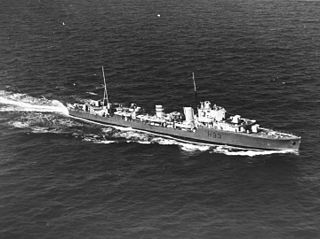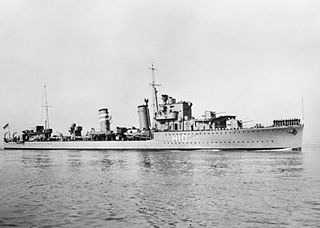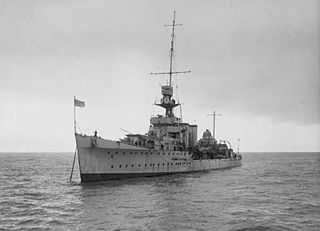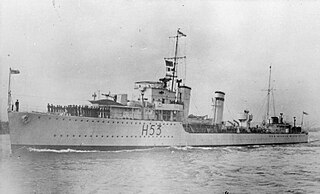
HMS Kingston was a K-class destroyer built for the Royal Navy during the 1930s.

HMS Jaguar was a J-class destroyer of the Royal Navy. Commissioned in September 1939, she was present at the Dunkirk evacuation the following year, during which Jaguar was damaged by dive bombers. She later served in the Mediterranean and was involved in several actions there. She was torpedoed off the coast of Egypt on 26 March 1942 and sunk.

HMS Hotspur was an H-class destroyer built for the Royal Navy during the 1930s. During the Spanish Civil War of 1936–1939 the ship spent considerable time in Spanish waters, enforcing the arms blockade imposed by Britain and France on both sides of the conflict. During the Norwegian Campaign of the Second World War, she fought in the First Battle of Narvik in April 1940 where she was badly damaged. After her repairs were completed, Hotspur was transferred to Gibraltar where she participated in the Battle of Dakar in September. A month later the ship was badly damaged when she rammed and sank an Italian submarine. She received permanent repairs in Malta and was transferred to the Mediterranean Fleet when they were finished in early 1941. Hotspur participated in the Battle of Cape Matapan in March and evacuated British and Australian troops from both Greece and Crete in April–May. In June the ship participated in the Syria-Lebanon Campaign and was escorting convoys and the larger ships of the Mediterranean Fleet until she was transferred to the Eastern Fleet in March 1942.

HMS Hero was an H-class destroyer built for the Royal Navy in the mid-1930s. During the Spanish Civil War of 1936–1939 the ship enforced the arms blockade imposed by Britain and France on both sides as part of the Mediterranean Fleet. During the first few months of World War II, Hero searched for German commerce raiders in the Atlantic Ocean and took part in the Second Battle of Narvik during the Norwegian Campaign of April–June 1940 before she was transferred to the Mediterranean Fleet in May where she escorted a number of convoys to Malta. The ship took part in the Battle of Cape Spada in July 1940, Operation Abstention in February 1941, and the evacuations of Greece and Crete in April–May 1941.

HMS Hereward, named after Hereward the Wake, was an H-class destroyer built for the Royal Navy in the mid-1930s. She was assigned to the Mediterranean Fleet before and the ship spent four months during the Spanish Civil War in mid-1937 in Spanish waters, enforcing the arms blockade imposed by Britain and France on both sides of the conflict. When the Second World War began in September 1939, the ship was in the Mediterranean, but was shortly transferred to the South Atlantic to hunt for German commerce raiders and blockade runners, capturing one of the latter in November. Hereward was transferred to the Home Fleet in May 1940 and rescued Queen Wilhelmina of the Netherlands after the Germans had invaded.

HMS Griffin (H31) was a G-class destroyer, built for the Royal Navy in the mid-1930s. In World War II she took part in the Norwegian Campaign of April–May 1940 and the Battle of Dakar in September before being transferred to the Mediterranean Fleet in November. She generally escorted larger ships of the Mediterranean Fleet as they protected convoys against attacks from the Italian Fleet. Griffin took part in the Battle of Cape Matapan in March 1941 and the evacuations of Greece and Crete in April–May 1941. In June she took part in the Syria-Lebanon Campaign and was escorting convoys and the larger ships of the Mediterranean Fleet until she was transferred to the Eastern Fleet in March 1942.

HMS Hasty was an H-class destroyer built for the Royal Navy during the mid-1930s. She was assigned to the Mediterranean Fleet until the beginning of World War II. The ship transferred to Freetown, Sierra Leone, in October 1939 to hunt for German commerce raiders in the South Atlantic with Force K. Hasty returned to the British Isles in early 1940 and covered the evacuation of Allied troops from Namsos in early May 1940 during the Norwegian Campaign. She was transferred back to the Mediterranean Fleet shortly afterwards and participated in the Battle of Calabria and the Battle of Cape Spada in July 1940. The ship took part in the Battle of Cape Matapan in March and evacuated British and Australian troops from both Greece and Crete in April and May. In June, Hasty participated in the Syria-Lebanon Campaign and was escorting convoys and the larger ships of the Mediterranean Fleet for the next year. During the Second Battle of Sirte in March 1942 she defended a convoy from an Italian battleship and several cruisers. While covering another convoy from Alexandria to Malta in June 1942 during Operation Vigorous, Hasty was torpedoed by a German motor torpedo boat and was so badly damaged that she had to be scuttled.

HMS Havock was an H-class destroyer built for the British Royal Navy in the mid-1930s. During the Spanish Civil War of 1936–1939, the ship enforced the arms blockade imposed by Britain and France on both sides as part of the Mediterranean Fleet. During the first few months of the Second World War, Havock searched for German commerce raiders in the Atlantic Ocean and participated in the First Battle of Narvik during the Norwegian Campaign of April–June 1940 before she was transferred back to the Mediterranean Fleet in May where she escorted a number of convoys to Malta. The ship took part in the Battle of Cape Spada in July 1940, the Battle of Cape Matapan in March 1941 and the evacuation of Greece in April 1941. She was damaged during the Battle of Crete the following month, but participated in the Syria–Lebanon Campaign in June.

HMS Duncan was a D-class destroyer leader built for the Royal Navy in the early 1930s. The ship was initially assigned to the Mediterranean Fleet before she was transferred to the China Station in early 1935 where she remained until mid-1939. Duncan returned to the Mediterranean Fleet just after World War II began in September 1939. She was transferred to the Home Fleet in December 1939, although she was badly damaged in a collision the following month, and required repairs that lasted until July 1940. The ship joined Force H at Gibraltar in October, escorting the larger ships and various convoys until March 1941 when she was transferred to West Africa for convoy escort duties for a few months. Duncan rejoined the 13th Destroyer Flotilla at Gibraltar in July and escorted several convoys to Malta during the rest of the year. After a refit, she briefly returned to the 13th Destroyer Flotilla before joining the Eastern Fleet in the Indian Ocean to participate in Operation Ironclad in May 1942. The ship was recalled home to be converted into an escort destroyer in late 1942.

HMS Mohawk was one of 16 Tribal-class destroyers built for the Royal Navy shortly before the beginning of Second World War in 1939. Completed in 1938 the ship was initially assigned to the Mediterranean Fleet. She was briefly involved enforcing the arms blockade on the combatants in the Spanish Civil War in early 1939. Mohawk returned home shortly after the start of the Second World War and was assigned convoy escort duties, during which she was damaged by German bombers. She played an active role in the Norwegian Campaign of April–May 1940, escorting convoys to and from Norway.

The G- and H-class destroyers were a group of 18 destroyers built for the Royal Navy during the 1930s. Six additional ships being built for the Brazilian Navy when World War II began in 1939 were purchased by the British and named the Havant class. The design was a major export success with other ships built for the Argentine and Royal Hellenic Navies. They were assigned to the Mediterranean Fleet upon completion and enforced the Non-Intervention Agreement during the Spanish Civil War of 1936–1939.

The E and F-class destroyers were a group of 18 destroyers built for the Royal Navy during the 1930s. The ships were initially assigned to the Home Fleet, although they reinforced the Mediterranean Fleet during the Italian invasion of Abyssinia of 1935–36 and enforced the Non-Intervention Agreement during the Spanish Civil War of 1936–1939. After the beginning of the Second World War in August 1939, the E-class ships were mostly assigned to escort duties under the Western Approaches Command, while the Fs were assigned to escort the ships of the Home Fleet. Between them they sank four German submarines through March 1940 while losing only one ship to a submarine.

Operation Collar was a small, fast three-ship convoy during the Second World War. The convoy left Britain on 12 November 1940 and passed Gibraltar on 24 November, escorted by two cruisers, two ships for Malta and one bound for Alexandria. Numerous other operations took place partly as diversions and the Italian Fleet sailed to attack British ships, leading to the inconclusive Battle of Cape Spartivento on 27 November. The two merchant ships reached Malta on 26 November.

HMS Legion was an L-class destroyer of the Royal Navy. She entered service during the Second World War, and had a short but eventful career, serving in Home waters and the Mediterranean. She was sunk in an air attack on Malta in 1942. The ship had been adopted by the British civil community of the Municipal Borough of Cheltenham, Gloucestershire in November 1941.

HMS Decoy was a D-class destroyer of the Royal Navy. Ordered in 1931, the ship was constructed by John I. Thornycroft & Company, and entered naval service in 1933. Decoy was initially assigned to the Mediterranean Fleet before she was transferred to the China Station in early 1935. She was temporarily deployed in the Red Sea during late 1935 during the Abyssinia Crisis, before returning to her duty station where she remained until mid-1939. Decoy was transferred back to the Mediterranean Fleet just before the Second World War began in September 1939. She briefly was assigned to West Africa for convoy escort duties in 1940 before returning to the Mediterranean. The ship participated in the Battles of Calabria without significant damage and escorted ships of the Mediterranean Fleet for most of the rest of the year.

HMS Calcutta was a C-class light cruiser of the Royal Navy, named after the Indian city of Calcutta. She was part of the Carlisle group of the C class of cruisers. She was laid down by Vickers Limited at Barrow-in-Furness in 1917 and launched on 9 July 1918. Calcutta was commissioned too late to see action in the First World War and was converted to an anti-aircraft cruiser in 1939. Calcutta served during the Norwegian Campaign and the evacuation from Dunkirk in 1940. She was used to escort allied convoys across the Mediterranean and was sunk on 1 June 1941 by Luftwaffe aircraft off Alexandria, Egypt.

HMS Forester was one of nine F-class destroyers built for the Royal Navy during the early 1930s. Although assigned to the Home Fleet upon completion, the ship was attached to the Mediterranean Fleet in 1935–36 during the Abyssinia Crisis. A few weeks after the start of World War II in September 1939, she helped to sink one German submarine and then participated in the Second Battle of Narvik during the Norwegian Campaign of 1940. Forester was sent to Gibraltar in mid-1940 and formed part of Force H where she participated in the attack on the Vichy French ships at Mers-el-Kébir and the Battle of Dakar between escorting the aircraft carriers of Force H as they flew off aircraft for Malta and covering convoys resupplying and reinforcing the island until late 1941. During this time the ship helped to sink another German submarine.

HMS Fury was an F-class destroyer built for the Royal Navy in the 1930s. Although assigned to the Home Fleet upon completion, the ship was attached to the Mediterranean Fleet in 1935–36 during the Abyssinia Crisis. During the Spanish Civil War of 1936–1939, she spent time in Spanish waters, enforcing the arms blockade imposed by Britain and France on both sides of the conflict. The ship escorted the larger ships of the fleet during the early stages of World War II and played a minor role in the Norwegian Campaign of 1940. Fury was sent to Gibraltar in mid-1940 and formed part of Force H where she participated in the attack on Mers-el-Kébir and the Battle of Dakar. The ship escorted numerous convoys to Malta in 1940–41 and Arctic convoys during 1942.

HMS Defender was a D-class destroyer built for the Royal Navy in the early 1930s. The ship was initially assigned to the Mediterranean Fleet before she was transferred to the China Station in early 1935. She was temporarily deployed in the Red Sea during late 1935 during the Abyssinia Crisis, before returning to her assigned station where she remained until mid-1939. Defender was transferred back to the Mediterranean Fleet just before World War II began in September 1939. She briefly was assigned to West Africa for convoy escort duties in 1940 before returning to the Mediterranean. The ship took part in the Battles of Calabria, Cape Spartivento, and Cape Matapan over the next year without damage. Defender assisted in the evacuations from Greece and Crete in April–May 1941, before she began running supply missions to Tobruk, Libya in June. The ship was badly damaged by a German bomber on one of those missions and had to be scuttled by her consort on 11 July 1941.

HMS Dainty was a D-class destroyer built for the Royal Navy in the early 1930s. The ship was initially assigned to the Mediterranean Fleet before she was transferred to the China Station in early 1935. She was temporarily deployed in the Red Sea during late 1935 during the Abyssinia Crisis, before returning to her assigned station where she remained until mid-1939. Dainty was transferred back to the Mediterranean Fleet just before World War II began in September 1939. She briefly was assigned to West Africa for convoy escort duties in 1940 before returning to the Mediterranean. The ship participated in the Battle of Calabria in July 1940 and was assigned to convoy escort and patrol duties until she was sunk by German bombers off Tobruk on 24 February 1941.


















